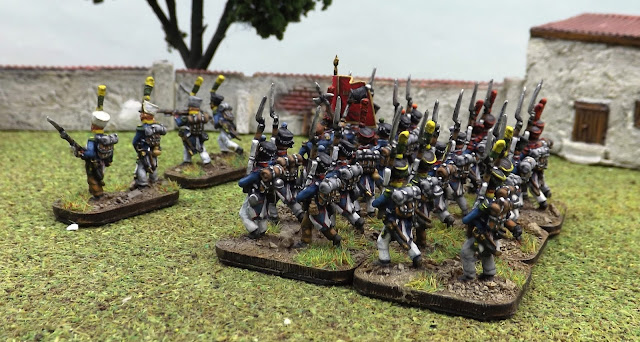The 45e Regiment's involvement in the fighting at Talavera spanned both the 27th and 28th of July 1809 starting on the afternoon of the 27th when Lapisse's 2nd Division, spearheaded Victor's surprise attack on the British rearguard of Mackenzie's 3rd Division caught unprepared for such an attack at Casa de Salinas.
This action was modelled over three plays of the scenario last year and you can pick up the details from the following:
Casa de Salinas- Pre Game Set Up
Casa de Salinas Game One
Casa de Salinas Game Two
Casa de Salinas Game Three
After the sharp action on the 27th the Allied army fell back relatively unmolested on to the selected position resting on the town of Talavera and the 45e Ligne along with its divisional comrades were held in reserve until the afternoon of the 28th July when the 2nd Division formed the extreme left of Victor's I Corps alongside the troops of Sebastiani's IV Corps and opposite the KGL brigades and Cameron's brigade in Sherbrooke's British 1st Division.
The details of the attack by Lapisse's men were covered fairly comprehensively in my post of the 3/8e Ligne.
3/8e Regiment de Ligne
Suffice to say the 45e Ligne alongside the 16e Legere were the lead brigade in the attack with the men of the 45e Ligne directly opposite the 2/83rd of Cameron's brigade.
The French attack by the first line of infantry columns was met with a close range single discharge of musketry followed up by a bayonet charge that caused them to break to the rear and fall back behind the second line of columns. The Guards and KGL over extended themselves in their pursuit of their beaten enemy and were caught by the second line French counter-attack that, after some desperate moments as the British line looked likely to be pierced, was equally repulsed by the reserves on hand.
This attack marked the high-water mark of the French infantry attacks for the day and the battle subsided as they withdrew that evening.
The losses reported for the 45e Ligne over the two days were 388 men of which three officers and forty-three men were killed and twelve officers, including Colonel Barri, and three hundred and twenty-eight men wounded and two men missing.
My 3/45e Ligne are composed of figures from AB and the battalion fanion is from GMB flags
 |
| Colonel Barri leads the three battalions of the 45e Regiment de Ligne |
Napoleon's Line Infantry, Osprey Men at Arms - Philip Haythornthwaite, Bryan Fosten
French Napoleonic Line Infantry - Emir Bukhari
Napoleon's Soldiers, The Grande Armee of 1807 (The Otto Manuscript) - Guy C Dempsey Jr.
Napoleonic Armies, A Wargamers Campaign Directory - Ray Johnson
Talavera, Wellington's First Victory in Spain - Andrew W. Field
The Peninsular War Atlas - Colonel Nick Lipscombe












Excellent post as always....and great looking figures!
ReplyDeleteCheers Phil, that's very kind.
DeleteJJ
Thank you for another great unit and post.
ReplyDeleteI am grateful you posted the image of the arrangement of Lapisse, Sebastiani and Leval too.
I have always thought it interesting that each of these three divisions, though all tasks with an offensive mission on the 28th, used different brigade deployments.
I think this shows clearly how flexible, and non-regulated, the options were for the French high command.
Lapisse chose to have one brigade in front and one behind.
Sebastiani chose to have his two brigades side by side.
Leval chose to have his three brigades in a single line, side by side, with effectively no second line (if we discount the Poles).
I, for one, find this fascinating.
Thank you Nigel,
DeleteThe deployment diagram is based on the illustration in Andrew Field's book and I agree makes a fascinating contrast between the various combat formation set ups.
In addition, he discusses the fact that Leval couldn't see the allied line beyond the olive groves and yet chose to put all his battalion columns in a single line rather than as a precaution have some following up in a second line to reinforce the attack on a weaker point of the allied line once it was discovered on leaving the tree line.
Additionally he points out that the columns in Laplanne's brigade (16e Legere, 45e Ligne) were "in column, but each column closed up to within six paces of each other, proving that there was never any intention of deploying into line." He goes on to say that Solignac's brigade following behind were deployed in battalion mass allowing Lapisse to bring them up quickly and in good order to exploit a breakthrough.
This formation strongly suggests that the French commanders at Talavera had little understanding of British line tactics and were doing what they always did against other continental opponents (massed artillery fire, skirmish attacks, followed up by their columns).
It would be great to be able to interview one of these chaps to see what they were thinking at the time. It seems to me that French commanders may have been loathe to allow their battalions to use line formation when attacking, given the problems of getting troops to move forward in that formation particularly once they have got into a fire-fight.
The other surprise is the absence of any cavalry to mix in among the infantry and hopefully take advantage of any weakness. Wellesley had the 14th and 16th Light Dragoons close on hand when his line looked threatened and they were instrumental in holding up the 32e and 75e Ligne until the infantry could restore the situation. Likewise the Spanish were able to throw in the El Rey heavy cavalry to complete the repulse of Leval and so French cavalry on hand may well have been very useful.
It really does pose lots of questions, just ripe for a wargame scenario.
Thanks for posting Jonathan another good read .
ReplyDeleteRegards Gavin .